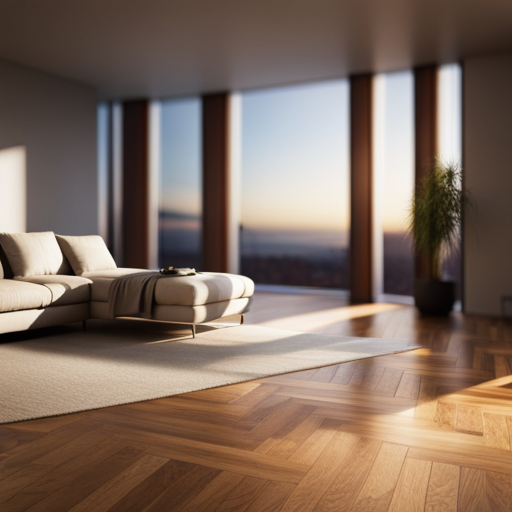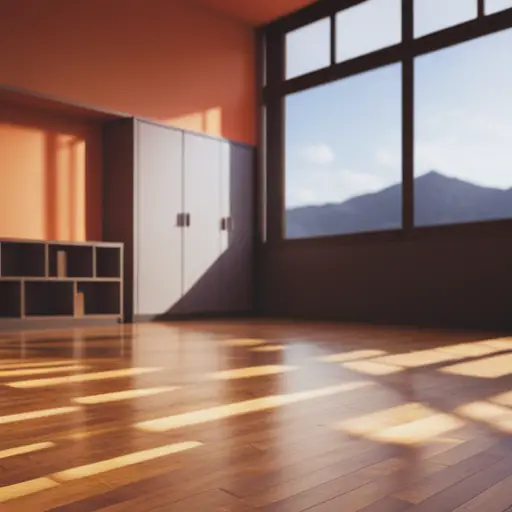The Impact of Flooring on Room Acoustics

As we step into a room, the flooring beneath our feet silently influences the acoustics around us. The impact of flooring on room acoustics is a complex and often overlooked aspect of interior design.
This article delves into the technical nuances of how different flooring materials can affect sound absorption, reflection, and ultimately, the overall sonic environment of a space. Understanding these dynamics is crucial for creating optimal acoustic conditions in any room.
Importance of Flooring in Acoustics
The importance of flooring in acoustics lies in its ability to significantly impact the sound quality and reverberation characteristics of a room. Flooring materials play a crucial role in determining the acoustics performance of a space.
Different flooring materials have varying acoustic properties, affecting how sound waves behave within a room. For instance, hard surfaces such as concrete or hardwood floors tend to reflect sound, leading to increased reverberation and a potential decrease in speech intelligibility. On the other hand, softer materials like carpets and cork flooring can absorb sound, reducing reverberation and improving speech clarity.
Understanding the acoustical properties of different flooring materials is essential for creating optimal sound environments in various settings, including auditoriums, classrooms, and offices. Moreover, the construction and installation of flooring can impact its acoustical performance, making it imperative to consider both material selection and installation techniques.
Given the significant role that flooring plays in room acoustics, it is essential to delve further into the concepts of sound absorption and reflection to comprehensively understand how to optimize acoustics within a space.
Sound Absorption and Reflection
Incorporating an understanding of sound absorption and reflection into the selection and installation of flooring materials is crucial for optimizing the acoustical performance of a space. Sound absorption refers to the process by which materials absorb sound energy rather than reflecting it. This is particularly important in spaces where excessive reverberation can negatively impact speech intelligibility and overall sound quality.
Flooring materials with high sound absorption coefficients, such as carpets and acoustic underlay, can significantly contribute to reverberation control within a room. Additionally, strategic placement of sound-absorbing materials on walls and ceilings can further enhance the overall soundproofing techniques employed in a space.
On the other hand, sound reflection occurs when sound waves bounce off surfaces, potentially leading to an increase in overall sound levels and reverberation time. Hard flooring materials like tiles and hardwood can contribute to sound reflection, necessitating the use of rugs or acoustic panels to mitigate excessive reverberation.
Impact of Different Flooring Materials
When considering the impact of different flooring materials on room acoustics, it is essential to evaluate their respective contributions to sound absorption and reflection within a space.
Wood flooring, known for its hard and reflective surface, tends to reflect sound, which can lead to a livelier acoustic environment.
Conversely, carpet, with its soft, fibrous nature, absorbs sound, reducing reflections and creating a more subdued acoustic atmosphere.
In the comparison of tile versus vinyl flooring, tile, similar to wood, has a hard and reflective surface, impacting room acoustics by increasing sound reflections.
On the other hand, vinyl flooring, especially when installed with an underlayment, offers sound absorption properties, thus decreasing the level of sound reflection within a space.
Understanding the acoustic characteristics of different flooring materials is crucial in achieving the desired sound environment.
Whether aiming for a vibrant, lively ambiance or a more subdued, controlled acoustic setting, the choice of flooring material plays a significant role in shaping the overall sound experience within a room.
Considerations for Specific Room Types
Considering the specific requirements of different room types, the choice of flooring material becomes crucial in achieving optimal acoustics. When selecting flooring for specific room types, factors such as room size and ceiling height play a critical role in determining the most suitable flooring material.
In home offices, where clear communication during virtual meetings is essential, the flooring should ideally reduce noise and reverberation.
In contrast, recording studios require flooring that minimizes sound reflections and is non-resonant to capture pure audio recordings.
Here are the key considerations for specific room types:
-
Room Size and Ceiling Height: Larger rooms with higher ceilings tend to have more sound reflections, requiring flooring materials with greater sound absorption to control reverberation.
-
Home Offices: Flooring in home offices should prioritize noise reduction to minimize distractions during work hours and enhance speech intelligibility during virtual meetings.
-
Recording Studios: For recording studios, non-resonant flooring materials such as cork or rubber are preferred to minimize sound reflections and ensure accurate audio recordings.
Enhancing Room Acoustics Through Flooring Choices
To enhance room acoustics, careful selection of flooring materials is essential. When considering room design and acoustic performance, the choice of flooring can significantly impact sound quality.
Hard surfaces such as hardwood, tile, or laminate flooring can create sound reflections, leading to increased reverberation and a livelier acoustic environment. On the other hand, carpet and area rugs can help absorb sound, reducing reflections and creating a more controlled acoustic space.
Additionally, the underlayment material used beneath the flooring can also contribute to the overall acoustic performance of the room. For example, acoustic underlayment can further reduce impact noise and improve sound insulation.
In the context of enhancing room acoustics through flooring choices, it is important to consider the specific acoustic requirements of the space. For areas where speech intelligibility is crucial, such as conference rooms or auditoriums, the selection of flooring materials should aim to minimize reverberation and control sound reflections.
Conversely, in spaces dedicated to musical performances, the flooring choices should be tailored to enhance the overall acoustic experience, balancing reverberation and sound absorption to achieve optimal sound quality. Therefore, the careful consideration of flooring materials and their acoustic properties is fundamental in achieving the desired acoustic performance within a given space.
Frequently Asked Questions
Can Flooring Impact the Acoustics of Outdoor Spaces or Open Areas?
Outdoor acoustics can be influenced by flooring materials, impacting reverberation in open spaces. The choice of flooring, such as concrete, grass, or asphalt, can affect sound reflection and absorption, contributing to overall outdoor sound quality.
Are There Any Regulations or Standards for Flooring Materials in Terms of Sound Absorption?
When it comes to regulations and standards for flooring materials, sound absorption standards are crucial. These standards ensure that flooring meets specific criteria for minimizing sound impact, particularly in outdoor spaces and open areas.
How Does the Installation Method of Flooring Affect Its Impact on Room Acoustics?
The installation methods of flooring significantly influence its impact on room acoustics. Proper installation can enhance acoustic performance by improving reverberation control and sound absorption. Understanding these methods is crucial in achieving optimal acoustic environments.
Are There Any Specific Flooring Materials That Are Recommended for Reducing Impact Noise From Foot Traffic or Furniture Movement?
When considering impact noise reduction and room acoustics, specific flooring materials play a crucial role. Factors such as sound absorption, reverberation time, and installation method significantly impact the effectiveness of flooring in reducing impact noise.
Can Flooring Choices Affect the Reverberation Time in a Room and if So, How Can This Be Measured or Adjusted?
Flooring choices can significantly affect the reverberation time in a room, impacting room acoustics. Measuring reverberation involves calculating the time taken for sound to decay. Adjusting flooring impact involves selecting materials with suitable sound absorption properties.
Conclusion
In conclusion, the choice of flooring material plays a significant role in the acoustics of a room. It has been shown that different materials have varying degrees of sound absorption and reflection, impacting the overall sound quality in a space.
By carefully selecting the appropriate flooring material, one can effectively enhance the acoustics of a room, creating a more harmonious and pleasant auditory experience for its occupants.
The flooring serves as a symbol of the foundation for achieving optimal room acoustics.

Rubin Everest, a seasoned expert in the world of flooring, brings a wealth of knowledge and passion to the surface. As the mind behind ebbow.com, Rubin is dedicated to sharing insights on the latest trends, innovative solutions, and expert advice in the realm of flooring. Whether you’re seeking practical tips for installation or design inspiration, Rubin Everest is your go-to source for all things flooring-related, making your journey to the perfect floor an informed and enjoyable experience.





